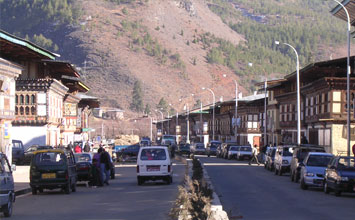

 The Kingdom of Bhutan (IPA: [bu?'t??n] Listen (help·info)) is a landlocked South Asian nation situated between India and China. The entire country is mountainous except for a small strip of subtropical plains in the extreme south which is intersected by valleys known as the Duars. The elevation gain from the subtropical plains to the glacier-covered Himalayan heights exceeds 7,000 m (23,000 feet). Its traditional economy is based on forestry, animal husbandry, and subsistence agriculture, however these account for less than 50% of the GDP now that Bhutan has become an exporter of hydroelectricity.[2] Cash crops, tourism, and development aid (the latter mostly from India)[3] are also significant. An extensive census conducted in April 2006 resulted in a population figure of 672,425. Thimphu is the capital and largest city.
The Kingdom of Bhutan (IPA: [bu?'t??n] Listen (help·info)) is a landlocked South Asian nation situated between India and China. The entire country is mountainous except for a small strip of subtropical plains in the extreme south which is intersected by valleys known as the Duars. The elevation gain from the subtropical plains to the glacier-covered Himalayan heights exceeds 7,000 m (23,000 feet). Its traditional economy is based on forestry, animal husbandry, and subsistence agriculture, however these account for less than 50% of the GDP now that Bhutan has become an exporter of hydroelectricity.[2] Cash crops, tourism, and development aid (the latter mostly from India)[3] are also significant. An extensive census conducted in April 2006 resulted in a population figure of 672,425. Thimphu is the capital and largest city.
Bhutan is one of the most isolated nations in the world; foreign influences and tourism are regulated by the government to preserve its traditional Tibetan Buddhist culture. Most Bhutanese follow either the Drukpa Kagyu or the Nyingmapa school of Tibetan Buddhism. The official language is Dzongkha (lit. "the language of the dzong"). Bhutan is often described as the last surviving refuge of traditional Himalayan Buddhist culture.
Bhutan is linked historically and culturally with its northern neighbor Tibet, yet politically and economically today's kingdom has drawn much closer to India.
Bhutan has been a monarchy since 1907. The different dzongkhags were united under the leadership of the Trongsa Penlop. King Jigme Singye Wangchuck, who has made some moves toward constitutional government, announced in December 2005 that he would abdicate in 2008 in favour of his eldest son. On December 14, 2006, he announced that he would be abdicating immediately, and his son, Jigme Khesar Namgyal Wangchuck, took the throne.